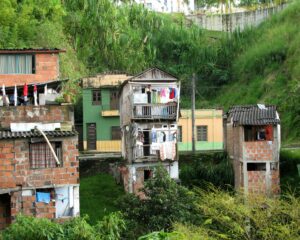Planning And Management Of Urban Slums And Squater Settlements
Introduction:
In 2012, according to UN-Habitat, about 863 million people in the developing world lived in urban slums. As per UN Habitat a slum is characterized by lack of durable housing, insufficient living area, and lack of access to clean water, inadequate sanitation and insecure tenure. Around the world, there are about 1 billion slum dwellers, and the number is expected to grow to 1.4 billion by the year 2020. Slums form and grow in many different parts of the world for many different reasons.

Some causes of slum development include rapid rural-to-urban migration, economic stagnation and depression, high unemployment, poverty, informal economy, poor planning, politics, natural disasters and social conflicts. Rural people migrate to urban areas in search for better jobs, better schools for their children and for diverse income opportunities. Improving quality of life in the slum is one of the Millennium Development Goals of the United Nations. Strategies tried to reduce and transform slums in different countries, with varying degrees of success, include a combination of slum removal, slum relocation, slum upgrading, urban planning with city wide infrastructure development, and public housing projects.
Rural and urban slums migration:
Rural and urban slums migration is one the major causes for the formation and creation of slum. Some of the factors that trigger rural-urban migration include: Low economic productivity: The proportion of people working in agriculture has declined by 20- 30% over the last 50 years, while global population has increased by 250%. People have largely moved from the countryside to the cities voluntarily in order to exploit the perceived economic opportunities.
Poor housing planning:
Inadequate housing in a major issue in the urban cities due to lack of planning with respect to the current and projected population. The main causes of poor housing planning are insufficient financial resources to create affordable public housing or improve slums and lack of coordination in government bureaucracy i.e. different departments in charge of economic development, urban planning, and land allocation. This is forcing people to opt for makeshifts and substandard housing which in turn leads to slum development.
Economic stagnation and depression:
Economic stagnation is characterized by high rate of unemployment, insufficient financial resources and inconsistent urban planning policy. In such circumstances, an increase of 1% in urban population will result in an increase of 1.84% in slum prevalence.
Urbanization:
It is closely linked to the formation of slum. Rapid urbanization creates economics growth, which attracts people to get employment and investment opportunities in the urban area. However as evidenced by poor urban infrastructure and insufficient housing, the local governments are unable to manage large population which gives rise to slum because of insufficient funds and inexperience to handle and organize issues that come along with urbanization.
Politics:
Many local and national level politicians for their political interest, subvert efforts to remove, reduce or upgrade slum into better housing options for the poor. During the second half of the 19th century, i.e. political parties of the French relied on votes of slum population and they are engaged in maintaining that voting bloc. Replacement and removal of slum created a conflict of interest, and politics prohibited efforts to remove, relocate or upgrade the slums into housing projects that are better than the slums. Similar situations are found in the slum of Brazil, slums of India, and slums of Kenya.
Lack of low-cost housing:
Many cities do not provide low-cost-housing to the large number of rural migrants who ultimately opt to settle down in affordable slums. Provision of low cost houses with basic necessities e.g. water and sanitation can help curb development of slums.
Natural disasters and social conflicts:
Peoples migrate to unaffected areas from affected areas due to major natural disasters and social conflicts in poor nations. Initially migrated people settle in temporary tent in cities which creates expansion of existing slum. With time passes these slums convert into permanent as these migrated peoples do not want to leave the current place.
Conclusion:
Urban slums exist in every country and have become a global phenomenon. The government should not just put up measures to help address the problem of slums. Instead, it should go deeper to ensure that the measures are effective and that any implementation issues are sorted out e.g. through ensuring participation of the targeted community, fighting with corruption and promoting good governance, better policy planning, ensuring coordination between stakeholders etc.
Also Read: Private investment solve the affordable housing shortage through re-invention 2024
